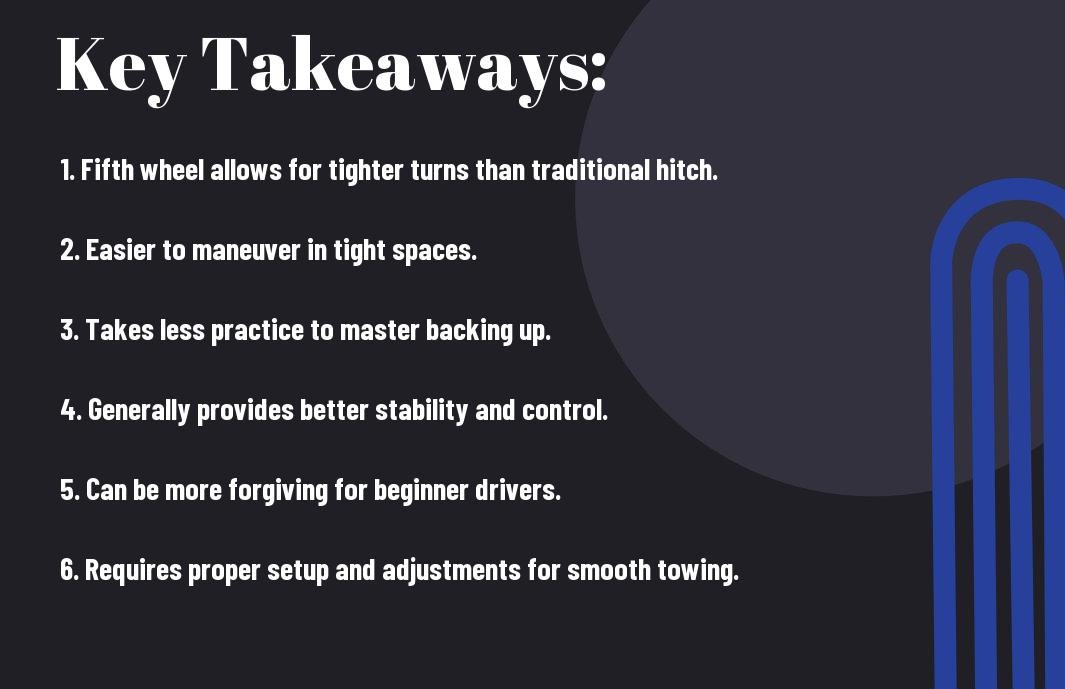Maneuvering a fifth wheel trailer can be an overwhelming task for many drivers. However, once you understand the unique turning mechanism of a fifth wheel hitch, you’ll find that backing up becomes significantly easier. The pivot point, located closer to the back of the towing vehicle, allows for tighter turns and greater control during reversing maneuvers. This is in stark contrast to conventional trailers, where the pivot point sits further back, leading to more challenging backing up situations. Additionally, the increased visibility and maneuverability of a fifth wheel trailer makes it easier to navigate tight spaces and tricky parking spots. Understanding and mastering the technique of backing up a fifth wheel trailer can ultimately provide you with a greater sense of confidence and ease when towing in various environments.
Key Takeaways:
- Shorter turning radius: Fifth wheels generally have a shorter turning radius, making it easier to maneuver and back up in tight spaces compared to traditional trailers.
- More stability: Fifth wheels have better stability when backing up, as the hitch is located closer to the truck’s rear axle, reducing the chance of swaying or jackknifing.
- Easier to see: The elevated position of the fifth wheel hitch provides better visibility, making it easier to see the trailer and obstacles when backing up.
- Insight into trailer position: The design of a fifth wheel provides better feedback to the driver about the trailer’s position, making it easier to make precise backing maneuvers.
- Improved handling: Many drivers find that fifth wheels are easier to back up due to improved handling and control, especially when making sharp turns or backing into a campsite.
- Learning curve: While fifth wheels offer advantages when it comes to backing up, there may still be a learning curve for some drivers to get used to maneuvering and controlling the trailer.
- Overall, fifth wheels are generally easier to back up and maneuver in tight spaces compared to traditional trailers, but it may still require practice and skill to master.

Basics of Backing Up a Trailer
Even if you have experience towing a trailer, backing up can be a daunting task. The concept of steering the trailer in the opposite direction of where you want it to go can be confusing and takes some getting used to. However, with practice and the right techniques, you can become a pro at backing up your trailer, including a fifth wheel.
Conventional Trailers vs. Fifth Wheels
When it comes to backing up, fifth wheel trailers have an advantage over conventional trailers. The main difference lies in the pivot point of the trailer. For a conventional trailer, the pivot point is at the hitch ball on your vehicle, which can cause the trailer to sway and be difficult to maneuver in reverse. On the other hand, the pivot point for a fifth wheel is located in the bed of your truck, providing better control and maneuverability when backing up.
Key Factors in Maneuverability
When backing up any type of trailer, there are a few key factors that affect maneuverability. The length of the trailer and the wheelbase of your towing vehicle play a crucial role in the ease of backing up. Additionally, the angle at which you approach the parking spot or campsite, as well as the type of terrain, can impact how smoothly you can reverse. Good visibility from your mirrors and having someone outside to guide you can also make a huge difference in your ability to back up accurately and safely.
- Trailer length and wheelbase
- Approach angle and terrain
- Visibility and having a spotter
Recognizing these key factors and practicing your backing up skills will ultimately make the process easier and less stressful.
Advantages of Backing Up a Fifth Wheel
For many people, the thought of backing up a fifth wheel can be intimidating. However, there are several advantages to backing up a fifth wheel that make it easier and more efficient than backing up a traditional trailer.
Pivot Point Location
One of the biggest advantages of backing up a fifth wheel is the location of the pivot point. Unlike traditional trailers, which pivot at the hitch on the bumper of the towing vehicle, fifth wheels pivot at a point located directly over the rear axle of the towing truck. This means that when you turn the steering wheel while backing up, the fifth wheel will follow a more natural and predictable path. This makes it easier to maneuver in tight spaces and around corners, giving you more control and reducing the likelihood of jackknifing.
Enhanced Stability During Reversing
When it comes to backing up, stability is key. Fifth wheels are known for their enhanced stability during reversing. The weight of the fifth wheel is distributed more evenly between the front and rear axles of the towing vehicle, which makes for a more stable and balanced towing experience. This stability translates to greater confidence and control when backing up, reducing the risk of swaying or fishtailing. This is especially important in situations where precision and accuracy are crucial, such as when maneuvering into a tight campsite or navigating through a crowded parking lot.
Challenges in Backing Up a Fifth Wheel
Despite the many advantages of a fifth wheel, backing it up can pose some unique challenges. The size and weight distribution of a fifth wheel trailer can make it more difficult to maneuver, especially for new users. Additionally, the learning curve for backing up a fifth wheel can be steep, requiring practice, patience, and a good understanding of the dynamics involved.
Size Considerations
When it comes to backing up a fifth wheel, size definitely matters. The longer length and larger turning radius of a fifth wheel trailer can make it more challenging to navigate tight spaces and tricky backing maneuvers. You’ll need to be mindful of the added length and height of the trailer, as this can impact your visibility and clearance, especially in crowded or confined areas. It’s important to always be aware of your surroundings and to take extra caution when maneuvering in tight spaces.
Learning Curve for New Users
If you’re new to towing a fifth wheel, you may find that there is a steep learning curve when it comes to backing it up. The dynamics of maneuvering a fifth wheel are different compared to traditional trailer towing, and it may take some time to get the hang of it. You’ll need to learn how to anticipate the trailer’s movements and how to make precise turns and adjustments to successfully navigate tight spots. Practice and patience are key as you familiarize yourself with the unique handling characteristics of a fifth wheel trailer.
Tips and Techniques
After practicing the basics of backing up a fifth wheel, you can refine your skills with the following tips and techniques:
- Adjust your mirrors to get a clear view of the trailer and the surrounding area. This will help you better gauge the direction and angle of your trailer as you back up.
- Use hand signals to communicate with a spotter if you have one. Make sure you establish clear signals for accelerating, stopping, turning, and correcting the trailer’s path.
- Take it slow and be patient. Rushing the backing up process can lead to mistakes and frustration. Remember, practice makes perfect.
This will help you gain confidence and improve your overall towing and backing up skills.
Preparing to Reverse a Fifth Wheel
Before you even start backing up, you need to prepare yourself and your vehicle. Make sure to:
- Double-check your hitch and ensure it is securely connected to the trailer.
- Adjust your mirrors to have a clear view of the trailer and the surrounding area.
Advanced Backing Maneuvers
If you want to take your backing up skills to the next level, you can try the following advanced maneuvers:
- Jackknifing: In this maneuver, you’ll need to pivot the trailer and the tow vehicle sharply to create a 90-degree angle between them.
- Blind Side Backing: This involves backing up from the passenger side, where visibility is limited. It’s a challenging maneuver that requires extra caution.
| Maneuver | Description |
| Jackknifing | Pivoting the trailer and the tow vehicle sharply to create a 90-degree angle between them. |
| Blind Side Backing | Backing up from the passenger side, where visibility is limited. It’s a challenging maneuver that requires extra caution. |
These advanced maneuvers can be tricky, but mastering them will significantly enhance your backing up skills.
Is a Fifth Wheel Easier to Back Up?
Taking this into account, you can conclude that yes, a fifth wheel is indeed easier to back up compared to a traditional travel trailer. The pivot point being located over the rear axle of your truck provides you with better control and maneuverability, making it simpler to navigate tight spots and reverse into campsites. Additionally, the visibility and predictability of the fifth wheel’s movement allow for more precision in your backing up efforts. Overall, the design and mechanics of a fifth wheel make it a favorable choice for those who are looking for an easier towing and backing up experience.
FAQ
Q: Is a fifth wheel easier to back up than other types of trailers?
A: Yes, a fifth wheel is generally easier to back up than other types of trailers. The design of a fifth wheel allows for better maneuverability and stability, making it easier for drivers to back up with precision.
Q: What makes a fifth wheel easier to back up?
A: The placement of the hitch point in the bed of the truck, as well as the pivot point being located closer to the rear axle of the towing vehicle, allows for greater control and maneuverability, making backing up a fifth wheel easier compared to other trailer types.
Q: Are there any specific tips for backing up a fifth wheel?
A: Yes, it is recommended to use a spotter to guide the driver from outside the vehicle. Additionally, practicing in an open space to get a feel for how the fifth wheel responds to steering inputs can help improve confidence and skill when backing up.
Q: Are there any challenges to consider when backing up a fifth wheel?
A: One challenge to consider is the potential for jackknifing, where the trailer folds too far and comes into contact with the towing vehicle. This can be avoided by taking slow, deliberate movements and paying close attention to the positioning of the trailer during the backing up process.
Q: Do I need special equipment or training to back up a fifth wheel?
A: While special training isn’t necessarily required, it’s highly recommended to familiarize yourself with the handling characteristics of a fifth wheel and to practice in a safe, open area before attempting to back up in more confined spaces. Additionally, having a properly installed hitch and an understanding of how it operates can help ensure a smoother backing up experience.
